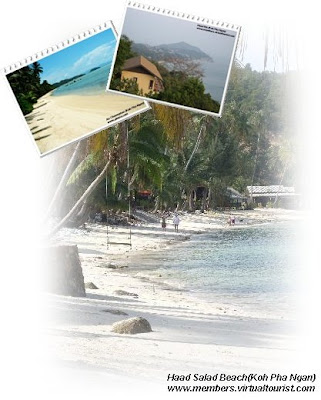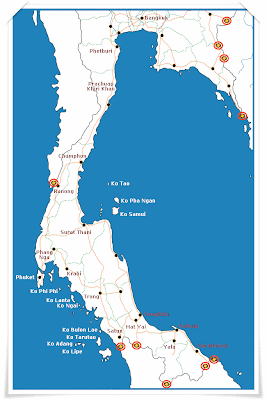As Highway 4 switches from the east flank of the Thailand peninsula to the Andaman coast it enters a markedly different country : nourished by rain nearly all the year round, the vegetation down here is lushly tropical, with forests replacing up to 80m in height, and massive rubber and coconut plantations replacing the rice and sugar-cane fields of central Thailand. In this region’s heartland the drama of the landscape is enhanced by sheer limestone crags, topographical hallmarks that spike every horizon and make for stunning views from the road. Even more spectacular and the main crowd-puller – is the Andaman Sea itself : translucent turquoise and so clear in some places that you can see to a depth of 30m, it harbors the country’s largest
coral reefs and is far and away the top diving area in Thailand.

Unlike the Gulf coast, the Andaman coast is hit by the southwest monsoon form May to October, when the rain and high seas render some of the outer islands inaccessible. However, conditions aren’t generally severe enough to ruin a holiday on the other islands, while the occasional mainland cloudburst is offset by the advantage of notably less expensive and crowded accommodation. Although some bungalows at the smaller resorts shut down entirely during low season.
Eager to hit the high-profile beaches of
Phuket Island and
Krabi, most people either fly over the first three-hundred-kilometer stretch of the west coast or ass through it on an overnight bus, thereby missing out on the lushly forested hills of Ranong province and bypassing several gems: the tiny and still idyllic island of Chang Island (not to be confused with its larger, more famous namesake off the east coast); the
Surin Island and
Similan Island island chains, whose reefs rate alongside the Maldives and the Great Barrier Reef; the enjoyable
Khao Sok National Park, where you can stay in a tree-house beneath the shadows of looming limestone outcrops; and the mid-market resort of Khao Lak, which hugs the rugged mainland coast on the edge of Khao Lak National Park. Tourism begins in earnest on
Phuket Island, Thailand’s largest island and the best place to learn to dive. The high-rises and consumerist gloss that characterize much of Phuket Island don’t appeal to everyone, however, and many travelers opt instead for the slightly less mainstream but very popular beaches around the former fishing village of
Krabi. Nearby the stunningly beautiful
Phi Phi Island attracts a lot of attention considering its size, and is beginning to crack under the strain, so many travelers have moved on again, searching out hideaways on
Lanta Island and bringing custom to the tiny retreats of
Jum Island and
Bubu Island.
Getting to Andaman coast destinations is made easy by Highway 4, also known as the Phetkasem Highway - and usually called Thanon Phetkasem when it passes through towns. The road runs from Bangkok to the Malaysian border, and frequent air-con and ordinary busses ply this route, connecting all major – and most minor – mainland tourist destinations. There is no rail line down the Andaman coast by bus before preceding southwards. Ferries to the most popular islands usually leave several times a day (with reduced services during the monsoon season), but for more remote destinations you may have to charter your own or wait for islanders’ trading boats to pick you up. Alternatively, you fly direct to the Andaman coast: there’s a busy international airport on Phuket, plus useful local ones in Krabi and Ranong.
Highlights
Khao Sok National Park – Sleep in a tree-house and wake to the sound of hooting gibbons. more ...
Similan Island – Remote chain of islands with some of the best diving in the word...
Reefs and wreaks – Dive Thailand’s finest underwater sights from Phuket Island,
Nang Island or
Phi Phi Island...
Phuket Island – Thailand’s largest island and p province in its own right. There are many activities of watersport, diving...
Sea-canoeing along the Krabi coastline – The perfect way to explore the region’s myriad mangrove swamps and secret lagoons...
Rock climbing on Leam Phra Nang – Get a bird’s eye view of fabulous coastlal scenery...
Lanta Island – The loveliest white sand beach...
Jum Island– Tiny island where there’s nothing to do but chill out...
 Pha Ngan Island, about half hour’s boat ride north of Samui Island, has become the island of choise for those who find Samui Island too crowded or too expensive. It started out as a sort of ‘back-door escape’ from Samui Island but is well established now, with a regular boat service and over 156 places to stay around the 190 sq km island. It’s definitely worth a visit for its remaining deserted beaches (they haven’t all been developed) and, if you like snorkeling, for its live-coral formations.
Pha Ngan Island, about half hour’s boat ride north of Samui Island, has become the island of choise for those who find Samui Island too crowded or too expensive. It started out as a sort of ‘back-door escape’ from Samui Island but is well established now, with a regular boat service and over 156 places to stay around the 190 sq km island. It’s definitely worth a visit for its remaining deserted beaches (they haven’t all been developed) and, if you like snorkeling, for its live-coral formations. Although hordes of backpackers have discovered Pha Ngan Island, the lack of an airport and relative lack of paved roads has so far spared it from tourist – hotel and package-tour development. Compared with Samui Island, Pha Ngan Island has a lower concentration of bungalows, less crowded beaches and coves, and an overall less ‘modern’ atmosphere. Pha Ngan Island aficionados say the sea food is fresher and cheaper than on Samui’s beaches, but it really varies form place to place. As Samui Island becomes more expensive for both travelers and investors, more and more people will be drawn to Pha Ngan Island. But for the time being, overall living costs remain about half what you’d pay on Samui Island.
Although hordes of backpackers have discovered Pha Ngan Island, the lack of an airport and relative lack of paved roads has so far spared it from tourist – hotel and package-tour development. Compared with Samui Island, Pha Ngan Island has a lower concentration of bungalows, less crowded beaches and coves, and an overall less ‘modern’ atmosphere. Pha Ngan Island aficionados say the sea food is fresher and cheaper than on Samui’s beaches, but it really varies form place to place. As Samui Island becomes more expensive for both travelers and investors, more and more people will be drawn to Pha Ngan Island. But for the time being, overall living costs remain about half what you’d pay on Samui Island.

 The one thing the Pattaya beach area has going for it is diving centers. There are over a dozen nice islands off Pattaya’s shore, although they can be expensive (compared with the rest of Thailand) to reach. If you’re a snorkeling or scuba enthusiast, equipment can be booked at any of the several diving shops/schools at Hat Pattaya beach.
The one thing the Pattaya beach area has going for it is diving centers. There are over a dozen nice islands off Pattaya’s shore, although they can be expensive (compared with the rest of Thailand) to reach. If you’re a snorkeling or scuba enthusiast, equipment can be booked at any of the several diving shops/schools at Hat Pattaya beach. 








